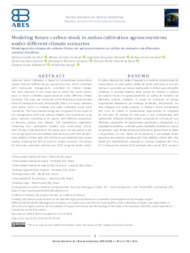Modeling future carbon stock in melon cultivation agroecosystems nder different climate scenarios.
Modeling future carbon stock in melon cultivation agroecosystems nder different climate scenarios.
Autoria: SILVA, V. C. da; SANTANA, M. da S.; PARENTE, A. G.; GONDIM, R. S.; SILVEIRA, C. da S.; SALVIANO, A. M.; DEUS, T. R. V. de; VALLADARES, G. S.; GIONGO, V.
Resumo: Intensive melon cultivation is based on conventional monoculture models that can inefficiently use natural resources, which, combined with inadequate management, contribute to climate change. The main objective of this study was to model the future carbon stock in melon cultivation agroecosystems under different climate scenarios. The study was conducted at the Bebedouro Experimental Field of Embrapa Semi-arid, Petrolina/PE, Brazil, in an area cultivated with yellow melon cv. Gladial, and eight cultivation cycles were considered. The experimental design was composed of two types of oil management (with and without tillage), two treatments using green manures consisting of 14 species with different proportions of legumes, grasses and oilseeds, and spontaneous vegetation, containing four replications divided into randomized blocks. After 70 days of development, the plants were cut and placed in the soil. Temperature and precipitation data were acquired from the BCC- CSM, MIROC5, CESM1-BGC, IPSL-CM5B-LR, and HadGEM2-AO climate models, following the RCP 4.5 and 8.5 climate scenarios. The carbon (C) stock was estimated until the year 2071 using the RothC model. The treatment with a predominance of legumes and no rotation increased the C stock in the soil, regardless of the climate scenario. The soil tillage did not favor C accumulation, meaning that none of the treatments reached the same stock as the Caatinga. The MIROC5 model in the RCP 4.5 scenario favored greater C accumulation in the soil, while the lowest C stocks occurred in the CESM1-BGC and IPSL-CM5B-LR models under the RCP 8.5 scenario.
Ano de publicação: 2024
Tipo de publicação: Artigo de periódico
Unidade: Embrapa Semiárido
Observações
1 - Por padrão são exibidas publicações dos últimos 20 anos. Para encontrar publicações mais antigas, configure o filtro ano de publicação, colocando o ano a partir do qual você deseja encontrar publicações. O filtro está na coluna da esquerda na busca acima.
2 - Para ler algumas publicações da Embrapa (apenas as que estão em formato ePub), é necessário ter, no celular ou computador, um desses softwares gratuitos. Sistemas Android: Google Play Livros; IOS: iBooks; Windows e Linux: software Calibre.
Acesse outras publicações
Acesse a Base de Dados da Pesquisa Agropecuária (BDPA) para consultar o acervo completo das bibliotecas da Embrapa.

